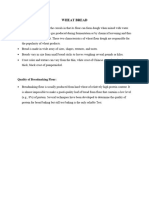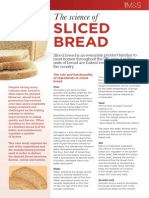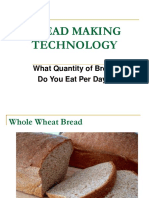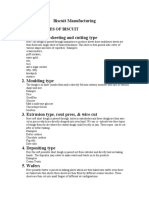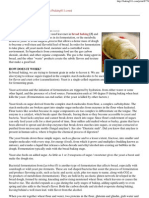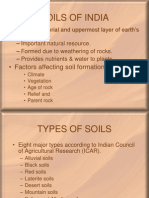Bread Lecture CPT
Uploaded by
Jessie Mae AntonioBread Lecture CPT
Uploaded by
Jessie Mae AntonioBREAD-
FUNCTION OF INGREDIENTS FOR BREAD
FLOUR STRUCTURE
1. Protein (Gliadin and Glutenin) plus Water= gluten= Gas Retention
2. Gelatinization of Starches 140-180 degrees Fahrenheit (60-82 degrees Celsius)
3. Average Gluten Content of Bread Flour (11-13%)
WATER HYDRATION
1. Combines with protein to form gluten
2. Combines with starch under high temperature for Gelatinization
3. Solvent and/for Dispersing Agent
4. Aids dough mobility
5. Temperature control of dough
Yeast is a single-celled microorganism that is a member of the Fungi kingdom.
• Yeast is found in nature and within our bodies; it consumes sugar and produces by-
products such as carbon dioxide, alcohol, and other chemical compounds.
• Yeast feeds on sugar and converts it into alcohol and carbon dioxide through
fermentation.
• Yeast is an essential ingredient in baking, brewing, and winemaking.
4 Different Types of Yeast for Baking
1. 1. Active dry yeast: If It consists of yeast granules covered with a protective coating.
The yeast is dormant until it is activated by warm water.
2. 2. Instant yeast: could be added directly to dry ingredients without prior activation. Both
professional and home bakers use instant yeast for its ease and reliability
3. 3. Cake yeast: Also known as compressed yeast, this fresh yeast consists of blocks of
moist, living yeast cells. Highly perishable, cake yeast can be stored in an airtight
container in the refrigerator for up to two weeks. Find it in the refrigerated section of
well-stocked grocery stores.
4. 4. Sourdough starter: Most people don't think of a sourdough starter as a type of yeast.
Fresh and dry commercial yeasts are made with particular strains of Saccharomyces
cerevisiae chosen for their bread-rising ability. A sourdough starter is made of naturally
occurring wild yeasts. It can last indefinitely, but it requires consistent maintenance.
Note: Saccharomyces cerevisiae (/ˌsɛrəˈvɪsi. iː/) (brewer's yeast or baker's yeast) is a
species of yeast (single-celled fungal microorganisms). The species has been instrumental
in winemaking, baking, and brewing since ancient times.
SALT ENHANCES FLAVOR
1. Helps control Fermentation
2. Toughens the gluten
3. Delayed salt method
MINERAL YEAST FOOD Controls the Fermentation and Bread Quality
1. Water Conditioner- Calcium Salt
2. Yeast Conditioner- Ammonium Salt
3. Dough Conditioner/Improver- Oxidizing Agent
SUGAR FOOD FOR THE YEAST
1. Flavor (residual sugar) Sweetness
2. Crust color (residual sugar) Caramelization and Browning reaction
3. Aids Shelf life
4. Types of Sugar (white/ granulated/refines sugar, brown sugar, honey, and molasses)
SHORTENING LUBRICATION
1. Ease of cell expansion and lubricate slicing blades
2. Improves dough handling
3. Extends shelf life
4. Tenderizes the crust
5. Types of fat
a. Lard (animal and Vegetable)
b. Butter
c. Margarine
d. Oil
MILK SOLIDS NUTRITION
1. Protein (high in Lysine and Calcium)
2. Crust color (protein and lactose sugar)
3. Flavor enhancement
4. Improved dough handling
ENRICHMENT NUTRITION
1. Iron= 12.5 mg/lb. of bread
2. Riboflavin= 1.1 mg/lb. of bread
3. Niacin= 15.0 mg/lb. of bread
4. Thiamin= 1.8 mg/lb. of bread
5. Calcium= 600.0 mg/lb. of bread
MOLD INHIBITORS
1. Retard mold growth and extend spoilage-free life
2. Also retard bacillus Mesenteric bacteria “rope-like texture”
3. Types of mold inhibitors
a. Calcium or Sodium propionate
b. Potassium sorbate
c. Sorbic acid
d. Vinegar
e. Raisin juice or crushed raisins
PROCESSES OF BREAD MAKING
MIXING
A. Purpose of mixing
1. To uniformly incorporate all ingredients
2. To obtain complete hydration of flour and other dry ingredients
3. To develop gluten for proper gas retention
B. Factors affecting Mixing
a. Speed of mixer
b. Mixer design
c. Dough size in relation to mixer capacity
d. Type of flour
e. Absorption
f. Dough temperature
g. Delayed salt method
h. Percent of shortening
FERMENTATION (resting the dough after mixing relaxes the gluten)
A. The process of leavening the dough. This process.
a. Produces carbon dioxide (volume)
b. Produce acids and alcohol (for flavor and aroma)
c. Biochemically condition the dough (by mellowing the gluten)
B. Factors which affect fermentation
a. Food supply
b. Water
c. pH
d. temperature
e. salt
CONVENTIONAL MAKE-UP
1. Dividing- scaling the dough piece to the proper weight. (bake loss)
2. Rounding- gives consistent shape for proper handling.
3. Intermediate proofing- allows the dough piece to relax (decrease in density) for proper
sheeting.
4. Sheeting- breaks up the large gas cells, subdividing them to produce finer grain. Also, it
reduces the dough pieces to a proper thickness for molding.
5. Molding- gives the dough piece the desired length and shape.
6. Panning- Place the dough piece in the center of the pan with the seam side down.
PROOFING
Leavening the product to obtain the desired appearance and eating qualities in the finished baked
products. (resting the dough before baking)
a. Proofing Temperature 95-100 degrees Fahrenheit (35-43 C)
b. Relative humidity 80-85%
Too dry= crusting
Too wet= spotting of crust and possible weak dough.
c. Proofing time 50-65 minutes
BAKING PROCESS OF BREAD
1. Bread increases in volume during the first 5 to 6 minutes of baking (over volume, oven
spring, oven kick)
2. Yeast activity ceases at 140-245 Degrees Fahrenheit (60-63C)
3. Proteins denature, and starch gelatinized, producing a firm crust between the reactions
occurring on the bread's surface.
4. Moisture is baked out to improve the finished product structure and shelf life.
BAKE LOSS
The loss of materials due to the evaporation of water and other volatile compounds.
1. 8 to 10 % product loss
2. 385 moisture content is the maximum allowed by FDA regulations for a standardized
bread roll.
THINGS THAT AFFECT BAKE LOSS
1. Formulation-moisture content, sugar, eggs, etc.
2. Baking temperature
3. Baking time
4. Fullness of oven (steam0
5. Size and shape of the product
6. Atmospheric conditions (temperature, humidity, air currents.
COOLING OF BREAD
To enable the slicing of the baked product with the maximum product loss.
1. Generally, an open-air system with 45 to 70 minutes of cooling time
2. Moisture loss during cooling 2-3%
3. Slicing temperature 90-100F (32-34C)
a. Smashing and tearing of product- too warm
b. Crumbling- too cool
c. Increased mold growth- too warm and moist
PACKAGING- the silent salesman
1. Communicate
a. Identity
b. Display
c. Inform
d. Instinct
e. Sell
2. Facilitate
a. Handling
b. Distribution
c. Use
d. Re-use
3. Protect
a. Moisture
b. Gasses and Fumes (odor)
c. Heat and Cold
d. Microbiological life (Bacteria molds)
MIXING METHOD
1. STRAIGHT DOUGH METHOD
A single-step mixing process whereby all the ingredients needed to produce a dough are
placed into a mixer at once.
Advantages
a. Reduced processing time
b. Reduce floor space (small fermentation room-fewer throughs)
c. Reduced equipment (1 mixer)
d. Reduced labor (less handling)
e. Good mixing tolerance
f. Excellent fermentation flavor and aroma
Disadvantages
a. Slightly higher ingredients cost
b. No chance to correct the mistakes (only 1 mixing)
c. Longer mixing time
2. SPONGE AND DOUGH METHOD
Two (2) mixing periods
Two (2) fermentation periods
Part of the ingredients are mixed and then allowed to ferment before the remaining
portions are added.
The first dough mass is called the sponge (part of the water, a little of sugar, yeast and
part of the flour), and then final dough is called dough.
Advantages:
a. Better tolerance to schedule delays (over fermentation)
b. Second chance to correct mistakes
c. Better loaf volume
d. Longer shelf life
Disadvantages
a. Poor mixing tolerance
b. More equipment and maintenance
c. Extra handling and manpower
3. NO-TIME DOUGH METHOD
No-time dough method (short time) is procedure for producing yeast leavened dough products
whereby there is a substantial reduction or elimination of the fermentation stage.
Advantages
a. Saving in time- reduced fermentation
b. Elimination of fermentation room
c. No sponge and dough inventory
d. Increase dough yield
Disadvantages
a. Absence of fermentation flavor and aroma
b. Poor shelf life
You might also like
- Baking Quality of Bread Flour - Sponge-Dough, Pound-Loaf MethodNo ratings yetBaking Quality of Bread Flour - Sponge-Dough, Pound-Loaf Method3 pages
- Sitxfsa002, Sitxinv002 - Written Assessment v250% (4)Sitxfsa002, Sitxinv002 - Written Assessment v224 pages
- Fermentation Product Bread Sem-3 (2021-22)No ratings yetFermentation Product Bread Sem-3 (2021-22)22 pages
- Prepare & Produce Bakery, Pastry & Cakes Products94% (48)Prepare & Produce Bakery, Pastry & Cakes Products198 pages
- Dietetic Technician, Registered Exam!: An All-Inclusive Guide To TheNo ratings yetDietetic Technician, Registered Exam!: An All-Inclusive Guide To The38 pages
- Bread Protein Wheat: Diabolical Efficiency Removes Bread's Most Precious Ingredient: TimeNo ratings yetBread Protein Wheat: Diabolical Efficiency Removes Bread's Most Precious Ingredient: Time5 pages
- Storage and Quality Testing of Bakery ProductsNo ratings yetStorage and Quality Testing of Bakery Products7 pages
- Biscuit Manufacturing: Different Types of BiscuitNo ratings yetBiscuit Manufacturing: Different Types of Biscuit15 pages
- Sourdough Mastery: A Comprehensive Guide to Perfecting the Art of Bread MakingFrom EverandSourdough Mastery: A Comprehensive Guide to Perfecting the Art of Bread MakingNo ratings yet
- Physical Activity and Nutrition: Lesson 1No ratings yetPhysical Activity and Nutrition: Lesson 115 pages
- Edited Food Processing 7 - 8-Module 1.2No ratings yetEdited Food Processing 7 - 8-Module 1.224 pages
- GST Price List - Dt. 14.12.18 - Updated MRPNo ratings yetGST Price List - Dt. 14.12.18 - Updated MRP11 pages
- Ethanolic Composition of False Yam Derivatives and Its Extraction Using Response Surface MethodologyNo ratings yetEthanolic Composition of False Yam Derivatives and Its Extraction Using Response Surface Methodology10 pages
- All Total The Summary of English Class 11No ratings yetAll Total The Summary of English Class 110 pages
- Proposal Honeymoon Package - Bali Komodo Package X 2tNo ratings yetProposal Honeymoon Package - Bali Komodo Package X 2t3 pages
- Carnivores Herbivores and Omnivores PowerPointNo ratings yetCarnivores Herbivores and Omnivores PowerPoint30 pages
- Template Layout (1) Afifah 227-236OK GALLEYNo ratings yetTemplate Layout (1) Afifah 227-236OK GALLEY10 pages
- WWW Manblunder Com Search Label Bhagavad 20gita Updated MaxNo ratings yetWWW Manblunder Com Search Label Bhagavad 20gita Updated Max37 pages
- Baking Quality of Bread Flour - Sponge-Dough, Pound-Loaf MethodBaking Quality of Bread Flour - Sponge-Dough, Pound-Loaf Method
- Dietetic Technician, Registered Exam!: An All-Inclusive Guide To TheDietetic Technician, Registered Exam!: An All-Inclusive Guide To The
- Bread Protein Wheat: Diabolical Efficiency Removes Bread's Most Precious Ingredient: TimeBread Protein Wheat: Diabolical Efficiency Removes Bread's Most Precious Ingredient: Time
- Sourdough Mastery: A Comprehensive Guide to Perfecting the Art of Bread MakingFrom EverandSourdough Mastery: A Comprehensive Guide to Perfecting the Art of Bread Making
- Ethanolic Composition of False Yam Derivatives and Its Extraction Using Response Surface MethodologyEthanolic Composition of False Yam Derivatives and Its Extraction Using Response Surface Methodology
- Proposal Honeymoon Package - Bali Komodo Package X 2tProposal Honeymoon Package - Bali Komodo Package X 2t
- WWW Manblunder Com Search Label Bhagavad 20gita Updated MaxWWW Manblunder Com Search Label Bhagavad 20gita Updated Max






